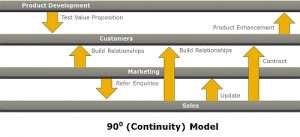Why Sales can no longer be a silo – collaboration rules!

Recently I heard someone say that the behaviour of the modern savvy buyer has caused the traditional sales model to be turned on its head. I’m not sure about that, but it definitely needs to be turned 90 degrees to the right. The traditional product cycle was to develop a product or service, pass it to marketing to promote, marketing would pass leads to sales and sales would follow up with the customer. It is no coincidence that this is illustrated with silos.

There was little interaction, except when Sales didn’t receive enough leads or Marketing failed to understand the value proposition. This worked for a while, but as buying behaviour changed, results dropped off. The relationship model has changed, and so must the product, marketing and sales cycles.
The new buyer has many attributes that make traditional sales methodologies less relevant today. SPI, the authors of the Solution Selling methodology refer to Buyer 2.0 which is a nice way of reinforcing the message that they are different now. The new buyer is tech-savvy and has access to plenty of desktop research options, so there is less need to engage with the seller early on. Also, after cycles of international crises and economic downturns, the buyer is very risk-aware and will do more checks and assessments than perhaps previously.
To be successful in developing trust between buyer and seller, the seller has to be prepared to work with the buyer from the earliest stage, long before there is a defined need, budget and timescale. This is not a natural place for a sales executive, schooled on BANT qualification criteria (Budget, Authority, Need, Time-scale), to operate.

Eades and Sullivan, in their book “The Collaborative Sale”, expect sellers to adopt new personas, one of which is the Micro Marketer. This means sales people have to proactively work with potential buyers, informing, building trust and enhancing reputation – long before BANT becomes a criteria.
Equally, marketing teams will need to adapt too. Events, email campaigns, advertising and telemarketing used to be prolific lead generators, but not now. Instead, Marketing has to support the early stage sales process where every contact with a potential buyer is a point on the buying journey. This introduces a whole new era of collaboration between sales and marketing to understand shared roles and responsibilities for supporting buyers on their journey towards a successful partnership.
This new focus on building relationships and communication extends further into the organisation than the traditional customer-facing roles. The companies that engage with the customer from product management, development, marketing, sales and customer services will build rich and lasting relationships that will drive increased revenue and customer loyalty.
Pure Potential works with organisations to develop cross-functional collaboration and support cultural change. These are often critical factors affecting adoption of new initiatives – even the best ideas won’t work unless the people are behind them.
Neville Merritt
